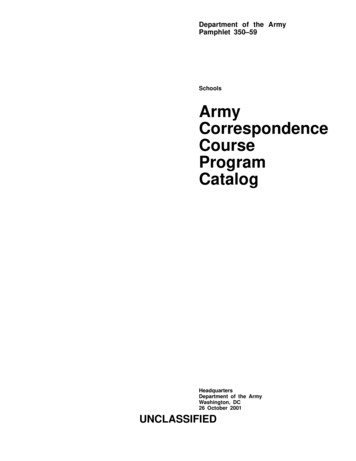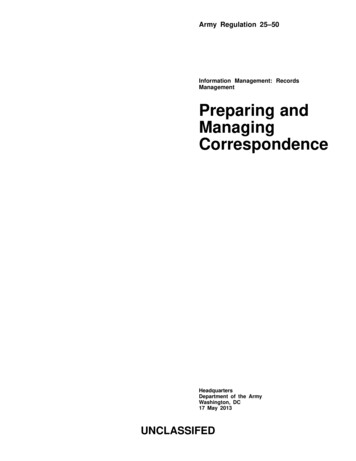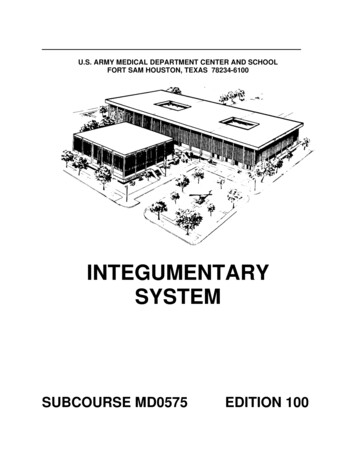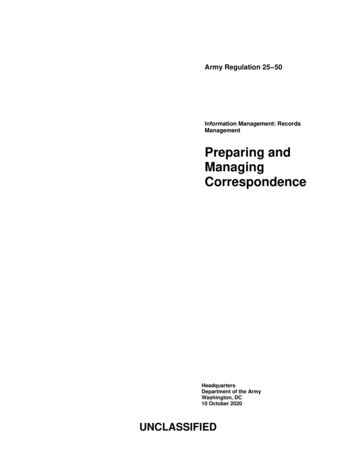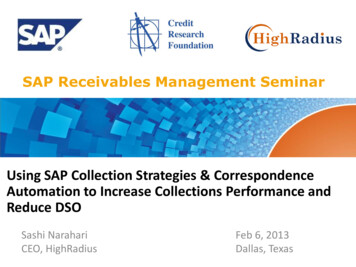
Transcription
SAP Receivables Management SeminarUsing SAP Collection Strategies & CorrespondenceAutomation to Increase Collections Performance andReduce DSOSashi NarahariCEO, HighRadiusFeb 6, 2013Dallas, Texas
Agenda SAP Collection Strategies– How to effectively segment customers? Sap Collections integration with A/R– Is it real-time? Correspondence Automation– How to make the computer do a lot of ‘standard repetitivework’ and refocus the analysts time on high value targets?2
DemoStandard SAP Collections ManagementHighRadius Advanced Correspondence Automation
SAP Collections Management UsersCollections Manager Define collection strategies /rules Define work item assignmentto users / groups Monitor and reallocation ofworkloadCollections Specialist Incoming / Outbound collectioncalls Process daily worklist based onprioritization Record customer contact andfollow up
Collections Management UsersCollections Manager
Data available for Collection Strategies Broken Promise toPay Number of Promiseto Pays Promise to PayAmount Customer Contacts Resubmissions Master Data orOperational Datawhich can be addedto collectionsmanagementCollectionsDataOpen AR &DisputeMgmt DataOther DataCredit Data AgingAmountDunning LevelAmount DunnedDisputed AmountDispute Case StatusPayment Data Credit Limit% UtilizationCredit ExposureRisk Category
Collections Strategy DefinitionCollectionStrategyCollectionRulesHigh to Medium Risk andgreater than 80% CreditLimit UtilizationValuation: 35 pointsCollection Strategy forHigh Risk CustomersMaximum Valuation 100Past Due Invoices Over 15days Past Due & DunnedOne or More TimesValuation: 50 pointsResubmission Due for theCustomerValuation: 15 points
Collection Strategy ValuationValuation ofcustomer isless than 40%of MaximumValuation of Valuation –customer is Mediumles thanPriority20% ofMaximumValuation –Low PriorityValuation ofcustomer isless than60% ofMaximumValuation –High PriorityValuation ofcustomer isless than orgreater thanequal to100% ofMaximumValuation –Very HighPriority
Solution ArchitectureSet ofCustomers[C1, C2, Cn]RulesStrategySubsetSet ofofCustomersCustomers[C1,[C1,C2,C2,C3 Cn] Cn]EmailAutoCorrespondenceFaxMailCall
Sample Scenario
Customer Segmentation Small & Medium Business – Slow Pay–––––Automated Proactive Reminder 7 days beforePast Due Notice 1 after 7 DaysPast Due Notice 2 after 21 DaysDemand Notice after 45 daysCall Customer after 60 days Small & Medium Business - Fast Pay– Past Due Notice 1 after 14 Days– Past Due Notice 2 after 28 Days– Call Customer after 50 days Major Accounts (Large Customers)– Proactive Reminder 14 days before– Past Due Notice 1 after 14 Days– Call Customer after 30 days
Collections Management: Collection StrategyStrategy forSlow PayCustomers Pro-active (0-20 points) 1st Past Due (21-40 points) 2nd Past Due (41-60 points) Demand Notice (61-80 points) Call (81-100 points)
Collections Management: Collection StrategyStrategy for FastPay Customers 1st Past Due (21-40 points) 2nd Past Due (41-60 points) Call (81-100 points)
Collections Management: Collection StrategyStrategy forMajorCustomers Pro-active (0-20 points) 1st Past Due (21-40 points) 2nd Past Due (41-60 points) Call (81-100 points)
Collections Management UsersCollections Specialist
Collections Management: Collector’s WorklistList ofCustomersPrioritized Pro-active (0-20 points) 1st Past Due (21-40 points) 2nd Past Due (41-60 points) Demand Notice (61-80 points) Call (81-100 points)
Is SAP Collections real-time? Short Answer: YES! Worklist generation is batch Say once a day Open Items is real-time Data is being read directlyfrom A/R17
Correspondence: From WorklistAbility to sendcorrespondencefrom WorklistSelect Pro-activeto mass process
Correspondence: Proactive ReminderSelect Package andwhich transactions toinclude incorrespondenceSelect Contact andCorrespondenceMode
Correspondence: Proactive Reminder
Correspondence: 1st Past DueSelect 1st PastDue to massprocess
Correspondence: 1st Past DueSelect 1st Past DuePackage
Correspondence: 1st Past Due
Correspondence: 2nd Past DueSelect 2nd PastDue to massprocess
Correspondence: 2nd Past DueSelect 2nd Past DuePackage & ‘Send’
Correspondence: Sample Email Correspondence
Correspondence: Sample Email CorrespondenceLetter and InvoiceCopy attachments
Correspondence: Sample Email Correspondence
Correspondence: Sample Email Correspondence
Correspondence: Demand NoticeSelect DemandNotice to process
Process Receivables: Customer Details ScreenSend correspondencebutton for individualcustomers
Correspondence: Demand NoticeSelect DemandNotice Package
Correspondence: Demand Notice
Correspondence: Package DefinitionSelect from a list of SmartForms, Documents suchas Invoice Copy, PODcopy etc to define a‘collated’ package
Correspondence: Maintain LettersSelect Letter toCreate/Edit
Correspondence: Maintain Letters
Correspondence: Maintain Letters
Correspondence: Maintain Letters
Correspondence: Maintain Letters
Correspondence: Maintain Letters
Correspondence: Maintain Letters
Correspondence: Maintain Letters
Collector’s Worklist: Call Customers‘Call’ customerswith high past duebalances or nooutcome aftercorrespondence
Collections Management: Invoice SummaryDefault Customer Contactreadily availableReview openitems to becollected
Collections Management: Payment HistoryReviewpaymenthistory
Customer Contact OutcomePromiseto ditionaldataRequestFollow up
Call Customer Outcome: Promise-to-PayCreatepromise topay on acollection call
Call Customer Outcome: Promise-to-PayRecord promisefor payment orcustomercontact at theinvoice level
Call Customer Outcome: Negotiate InstallmentsAbility to setupInstallment planson high riskcustomer
Collections Management: Promise-to-PayPromise forpayment hasbeen recorded
Collections Management: Promise-to-PaySummary ofall Promiseto Pay
Call Customer Outcome: Create Follow-upCreate aFollow-upreminder onspecificinvoices
Call Customer Outcome: Create Follow-upIdentify thedate of theresubmissionalong with aReason
Collections Management: ResubmissionSummary of allResubmission
Call Customer Outcome: Invoice DisputedCreateDisputes onInvoices
Call Customer Outcome: Invoice DisputedAbility to identifydetails of the disputeand route it to theappropriate analyst
Collections Management: Dispute CasesReview openand closeddispute cases
Notes ManagementSelect invoice andenter invoicespecific notes
Notes ManagementIdentify thereason of thenote
Collections Management: NotesSummary ofall Notes
Collections Management: Completed ItemTextWork itemcompleted
SAP Collections Management Users Define collection strategies / rules Define work item assignment to users / groups Monitor and reallocation of workload Incoming / Outbound collection calls Process daily w


